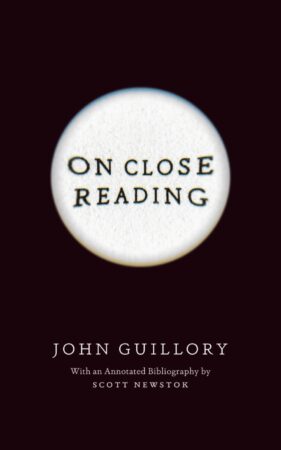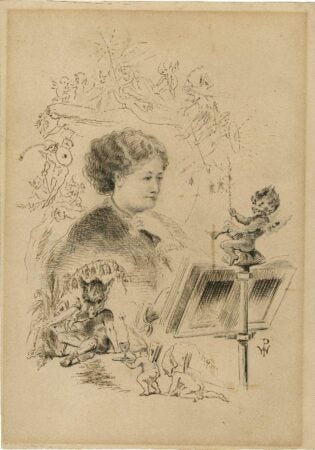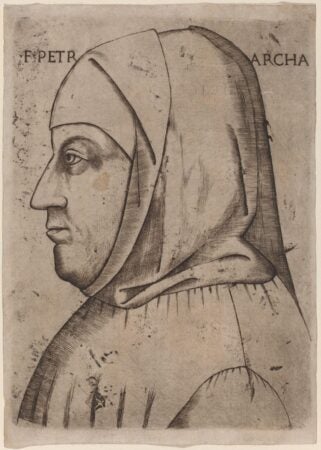The Close Reading Archive is a digital resource that reframes our understanding of the origins and evolution of Anglophone literary study. Developed collaboratively between John Guillory and Scott Newstok, the project combines a robust bibliographic infrastructure with a historical and theoretical investigation into one of the humanities’ defining practices. JSTOR was critical throughout in shaping the structure of these inquiries and providing access to relevant materials.
From intellectual exchange to digital architecture

Cover of “On Close Reading,” pub. University of Chicago Press.
The project is rooted in a long-standing scholarly dialogue. “Years ago, John Guillory shared with me his early drafts of a project on close reading,” recalls Newstok, executive director of the Spence Wilson Center for Interdisciplinary Humanities at Rhodes College. Guillory, who had been researching the topic since the 1980s, recently invited Newstok to join as a formal collaborator.
“In 2023, Guillory proposed a book, in which his argument would be supplemented by my annotated bibliography.”
Guillory’s On Close Reading became the foundation, while Newstok continued collecting and annotating references and commentary. The bibliography ultimately burgeoned to over 750,000 words, far surpassing the capacity for print publication.
To make this archive accessible, Newstok partnered with NYU graduate student Lili Hsu to develop a searchable database. At the same time, a student research assistant at Rhodes College, Ahyoung Hwang, helped regularize the formatting, resolve link rot, and structure the data into a coherent and navigable form.
“Each entry includes a kind of ‘tiered’ set of information: a key quotation (usually a central phrase, no longer than a sentence); an excerpt of key passages; and an external link. With this structure, a user can skim for pithy statements, delve more deeply into a quotation, or consult the original source in greater detail,” elaborated Newstok.
JSTOR’s role in facilitating recursive research
JSTOR served as a cornerstone for the Archive’s discovery process, taking advantage of advanced features such as automatic citations and refined search capabilities. As Newstok describes it:
“My forays through JSTOR and other online resources would meander from source to source, with new combinations of keywords becoming evident through chance encounters.”
These serendipitous connections were made navigable by JSTOR’s filtering tools. Newstok explains, “Sorting by relevance, or limiting searches to title or abstract, helped delimit the nearly 40,000 JSTOR entries that include the phrase ‘close reading’ (many of which don’t ultimately refer to the practice in literary studies, yet some of which are suggestive nonetheless).” He notes that the entire research process was “recursive,” with JSTOR’s on-platform citation feature as an effective facilitator.
This recursive approach allowed the Archive to trace the linguistic and conceptual predecessors of “close reading,” surfacing terms like “verbal analysis,” “explication,” and “close criticism.” What emerged was a lexicon that evolved alongside the discipline itself.
Discoveries that complicate the received history

W. P. A drawing of a person reading with the characters of A Midsummer Night’s Dream around her. 19th century. Folger Shakespeare Library. Artstor. https://jstor.org/stable/community.25238928.
Among the Archive’s insights is that the phrase “close reading” was rarely used by the very critics with whom it is now most often associated. Cleanth Brooks, for instance, experimented with a host of near-synonyms, yet showed reluctance to embrace the term even in his later writings. According to Newstok:
“The term’s applied retroactively—something subsequent critics invoked, sometimes in disdain.”
The Archive brings to light how close reading was never a monolith:
“No single rubric or set of ‘rules’ captures the practice. And that’s precisely Guillory’s point: close reading is a ‘cultural technique,’ one that’s modeled, case-by-case, through apprenticeship to skilled practitioners. The best close readers—whether Erich Auerbach or Eve Sedgwick—are responsive, inventive, and informed. There’s no formula for that.”
As a teaching resource, the Archive provides accessible models without insisting on any unique method:
“The archive offers enough variety to help instructors experiment, refine, and teach, without pretending there’s only one ‘right’ way.”
Community, pedagogy, and public scholarship
The Archive has already found a home in classrooms and professional communities, including a recent webinar from The English Association. Newstok reports that educators have used the tool to invite students into a broader scholarly ecosystem:
“It’s been gratifying to hear from other teachers who’ve consulted the Archive as a gateway for their students to explore JSTOR and other digital resources.”
On Close Reading and the Archive have also been spotlighted across scholarly venues:
- “A gift to the discipline.”—Dan Sinykin, The Nation
- “An astonishing and faintly Ozymandian monument of scholarly metadata.”—Colin Vandenburg, n+1
- “Newstok’s annotated bibliography…would constitute a notable contribution even if it had been published by itself.”—Joshua Gang, Modern Philology
A philosophy of collaboration and gratitude

Unknown artist. Portrait of Petrarch. ca. 1500. National Gallery of Art. Artstor. https://jstor.org/stable/community.23760784.
The Close Reading Archive exemplifies what it means to work within a living scholarly tradition. Newstok acknowledges the human network behind the project:
“Undertaking this project has renewed my appreciation for the countless people who undergird the ongoing work of the humanities—students, colleagues, editors, reviewers, publishers, technologists, the folks behind platforms like JSTOR.”
In an era of cultural skepticism toward the humanities, the Archive affirms their ongoing relevance. Quoting thinkers from Petrarch to Kenneth Burke, Newstok describes the archive as a portal into a perpetual dialogue:
“Treating writing and reading as a ‘conversation’ across time and space is an old conceit: we talk to books, and they talk back to us…. Part of what an archive like this helps make just a bit more visible is the ongoing effort that sustains these unending conversations—we’re not the first to discuss close reading, nor will we be the last.”
Explore the Archive
The preface of On Close Reading can be read online, courtesy of The University of Chicago Press. The Close Reading Archive itself is freely accessible, along with an overview of the bibliography, and a selection of its entries has been published open-access by Cambridge University Press. Together, these resources offer a glimpse into the history and evolution of literary criticism, and confirm how scholarship grounded in humanistic values continues to thrive in our digital era.
For librarians, faculty, and institutions
If your institution is invested in the humanities and social sciences and eager to support research that bridges tradition with innovation, JSTOR offers tailored solutions to make it possible.
With citation integration and long-term digital access, we equip libraries, faculty, and students with a research infrastructure designed for discovery and interdisciplinary impact. Learn more about how we can strengthen your institution’s research support on our website.